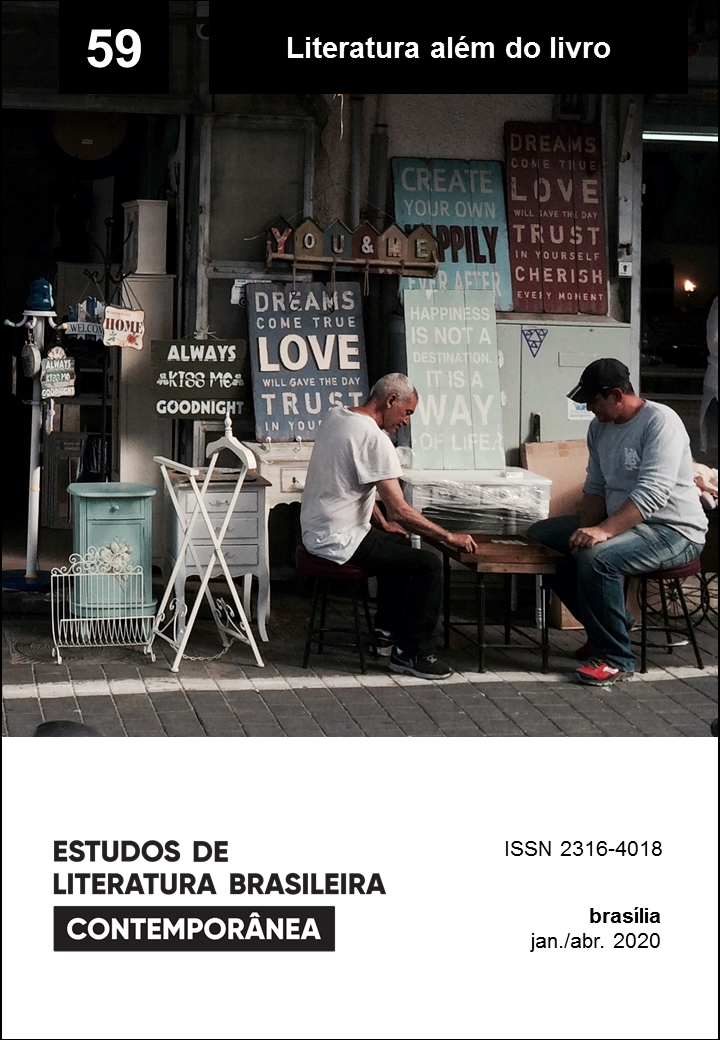The Flâneuse in Brazilian Literature: Contested Spaces and Temporalities
DOI:
https://doi.org/10.1590/2316-40185910Keywords:
flâneur, flâneuse, mobility, gender, literatureAbstract
The question of space and its “production”, following Lefebvre (1975), has emerged as a fertile field of enquiry for literary studies, also when related to question of mobility in different contexts: from experiences of migration and diaspora to urban transits, to cite a few. In this context, the figure of the flâneur, intrinsically connected to experiences and representation of urban modernity, has attracted considerable critical attention. However, little attention has been awarded to its female counterpart, the flâneuse, because, as Wolff (1985) rightly observes, the experience of modernity has been in great part narrated from a male perspective. Starting with the short story “Amor” [Love] by Clarice Lispector (1960/1998), and the text “Um corpo negro pelado” [A naked black body] by Miriam Alves (2014), the article will discuss how these texts seem to dialogue with this paradigm of modern mobility. It will consider how female mobility in Brazilian literature written by women express attempts to rethink mobility as a political act and as a search for female empowerment.
Downloads
References
ALVES, Miriam (2014). O corpo negro pelado. Modo de Usar & CO., 19 jan. Disponível em: https://bit.ly/362PqOC. Acesso em: 30 nov. 2017.
BAUDELAIRE, Charles (1857/1985). As flores do mal. Tradução de Ivan Junqueira.. Rio de Janeiro: Nova Fronteira. Edição bilíngue
BENJAMIN, Walter (1973). Charles Baudelaire: a lyric poet in the era of high capitalism. Londres: Verso.
BENJAMIN, Walter (1999). On some motifs in Baudelaire. In: BENJAMIN, Walter. Illuminations. Edição e introdução de Hannah Arendt. Prefácio de Leon Wieseltier. Tradução de Harry Zorn. Londres: Pimlico.
CARRERA SUÁREZ, Isabel (2015). The stranger flâneuse and the aesthetics of pedestrianism: writing the post-diasporic metropolis. Interventions, v. 17, n. 6, p. 853-865, 7 jan.
CERTEAU, Michel de (1980). L’invention du cotidien. Paris: Gallimard.
CHIARELLI, Stefania; OLIVEIRA NETO, Godofredo de (2016) (Org.). Falando com estranhos: o estrangeiro e a literatura brasileira. Rio de Janeiro: 7 Letras.
COSGROVE, Dennis (1984). Social formation and symbolic landscape. Londres: Croom Helm.
CRESSWELL, Tim (2006). On the move: mobility in the modern world. New York; Abingdon: Routledge.
FERGUSON, Priscilla Parkhurst (1994). The flâneur on and off the streets of Paris. In: TESTER, Keith (Ed.). The flâneur. Londres: Routledge. p. 22-42.
HARVEY, David (2008). The right to the city. The New Left Review, n. 53, p. 23-40, set./out.
LEFEBVRE, Henry (1968/1996). The right to the city. In: KOFMAN, Eleonore; LEBAS, Elizabeth (Ed.). Writings on cities. Cambridge, MA: Blackwell, p. 147-159.
LEFEBVRE, Henry (1974). La production de l’espace. Paris: Anthropos.
LISPECTOR, Clarice (1960/1998). Laços de família. Rio de Janeiro: Rocco.
LITERAFRO (2019). Miriam Alves. Disponível em: http://www.letras.ufmg.br/literafro/autoras/348-miriam-alves. Acesso em: 14 mar. 2019.
MORETTI, Franco (1998). An Atlas of the European Novel 1800-1900. Londres: Verso.
PEIXOTO, Marta (1994). Passionate fictions. Minneapolis; London: University of Minnesota Press.
POLLOCK, Griselda (1988). Vision and difference. Londres: Routledge.
ROBILA, Mihaela (2018). Refugees and social integration in Europe. New York: Undesa. Disponível em: https://bit.ly/2tgntpy. Acesso em: 22 fev. 2019.
ROSENTHAL, Anton (2016). The streetcar in the urban imaginary of Latin America. Journal of Urban History, v. 42, n. 1, p. 162-179, jan.
SCHULTE NORDHOLT, Annelies (2008). Georges Perec: topographies parisiennes du flâneur. Revue Électronique de Littérature Française, v. 2, n. 1, p. 66-86, 19 mar.
SHELLER, Mimi; URRY, John (Ed.) (2004). Tourism mobilities: places to play, places in play. London; New York: Routledge.
TONUS, José Leonardo (2012). O imigrante na literatura brasileira: instrumentalização de uma figura literária. In: DALCASTAGNÈ, Regina; MATA, Anderson Luís Nunes da (Org.). Fora do retrato: estudos de literatura brasileira contemporânea. Vinhedo: Horizonte. p. 93-101.
VILA-CABANES, Isabel (2018). The flaneur in nineteenth-century british literary culture: the worlds of London unknown. Newcastle: Cambridge Scholars Press.
WEJSA, Shari; LESSER, Jeffrey (2018). Migration in Brazil: the making of a multicultural society. The Online Journal of Migration Policy Institute, Washington, 29 mar. Disponível em: https://bit.ly/2uF3yRv. Acesso em: 7 mar. 2019.
WILSON, Elizabeth (1992). The invisible flâneur. New Left Review, n. 191, p. 90-110, jan./fev.
WOLFF, Janet (1985). The invisible flâneuse: women and the literature of modernity. Theory, Culture & Society, v. 2, n. 3, p. 37-46, nov.
Downloads
Published
How to Cite
Issue
Section
License
Authors who publish in this journal agree to the following terms:
a) The authors maintain the copyright and grant the journal the right of first publication, the work being simultaneously licensed under the Creative Commons Attribution License-Non Commercial 4.0 which allows the sharing of the work with acknowledgment of the authorship of the work and publication this journal.
b) Authors are authorized to enter into additional contracts separately, for non-exclusive distribution of the version of the work published in this journal (eg publish in institutional repository or as a book chapter), with authorship recognition and publication in this journal.
c) Authors are allowed and encouraged to publish and distribute their work online (eg in institutional repositories or on their personal page) after the editorial process, as this can generate productive changes, as well as increase the impact and citation of published work (See The Effect of Free Access).
d) The authors of the approved works authorize the magazine to, after publication, transfer its content for reproduction in content crawlers, virtual libraries and the like.
e) The authors assume that the texts submitted to the publication are of their original creation, being fully responsible for their content in the event of possible opposition by third parties.


